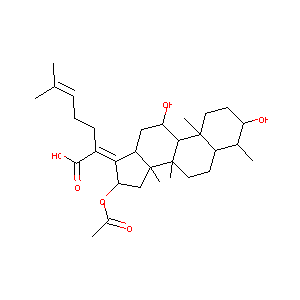Details of the Drug
General Information of Drug (ID: DMWVCF3)
| Drug Name |
Fusidic acid
|
|||||||||||||||||||||||
|---|---|---|---|---|---|---|---|---|---|---|---|---|---|---|---|---|---|---|---|---|---|---|---|---|
| Synonyms |
FUCIDIN; Fucidate; Fucithalmic; Fusidate; Fusidine; Ramycin; Diethanolamine fusidate; Fucidate Sodium; Fucidic acid; Fucidin acid; Fuci (TN); Fucibet (TN); Fucicort (TN); Fucidin (TN); Fucidin Cream 2%; Fucidine (TN); Fucithalmic (TN); Fucizon (TN); Fudic (TN); Fusiderm (TN); Fusidin (TN); SQ 16,603; Fusidic acid (USAN/INN); C.A.S. 62,602; (2Z)-2-[(17Z)-16beta-acetoxy-3alpha,11alpha-dihydroxy-4alpha,8alpha,10,14beta-tetramethyl-5alpha,9beta,13alpha-gonan-17-ylidene]-6-methylhept-5-enoic acid; (2Z)-2-[(3R,4S,5S,8S,9S,10S,11R,13R,14S,16S)-16-acetyloxy-3,11-dihydroxy-4,8,10,14-tetramethyl-2,3,4,5,6,7,9,11,12,13,15,16-dodecahydro-1H-cyclopenta[a]phenanthren-17-ylidene]-6-methylhept-5-enoic acid; (2Z)-2-[(3alpha,4alpha,5alpha,8alpha,9beta,11alpha,13alpha,14beta,16beta,17Z)-16-(acetyloxy)-3,11-dihydroxy-4,8,10,14-tetramethylgonan-17-ylidene]-6-methylhept-5-enoic acid; 16-(Acetyloxy)-3,11-dihydroxy-29-nordammara-17(20),24-dien-21-oic acid; 3.alpha.,11.alpha.,16.beta.-Trihydroxy-29-nor-8.alpha.,9.beta.,13.alpha.,14.beta.-dammara-17(20),24-dien-21-oic acid 16-acetate
|
|||||||||||||||||||||||
| Indication |
|
|||||||||||||||||||||||
| Therapeutic Class |
Antibiotics
|
|||||||||||||||||||||||
| Drug Type |
Small molecular drug
|
|||||||||||||||||||||||
| Structure |
 |
|||||||||||||||||||||||
| 3D MOL | 2D MOL | |||||||||||||||||||||||
| #Ro5 Violations (Lipinski): 2 | Molecular Weight (mw) | 516.7 | ||||||||||||||||||||||
| Topological Polar Surface Area (xlogp) | 5.5 | |||||||||||||||||||||||
| Rotatable Bond Count (rotbonds) | 6 | |||||||||||||||||||||||
| Hydrogen Bond Donor Count (hbonddonor) | 3 | |||||||||||||||||||||||
| Hydrogen Bond Acceptor Count (hbondacc) | 6 | |||||||||||||||||||||||
| ADMET Property |
|
|||||||||||||||||||||||
| Chemical Identifiers |
|
|||||||||||||||||||||||
| Cross-matching ID | ||||||||||||||||||||||||
Molecular Interaction Atlas of This Drug
 Drug Therapeutic Target (DTT) |
|
|||||||||||||||||||||||||||||||
|---|---|---|---|---|---|---|---|---|---|---|---|---|---|---|---|---|---|---|---|---|---|---|---|---|---|---|---|---|---|---|---|---|
 Drug-Metabolizing Enzyme (DME) |
|
|||||||||||||||||||||||||||||||
| Molecular Interaction Atlas (MIA) | ||||||||||||||||||||||||||||||||
References
